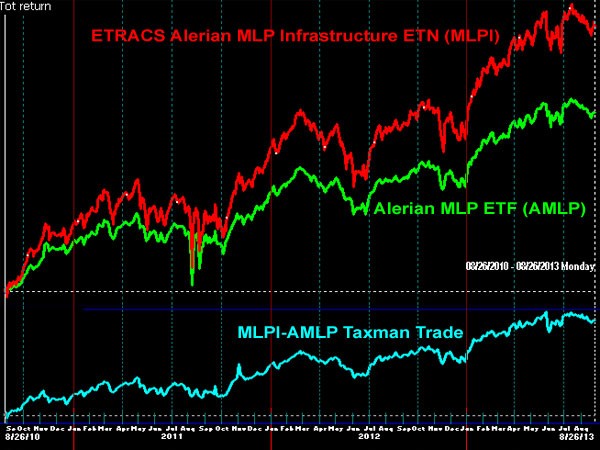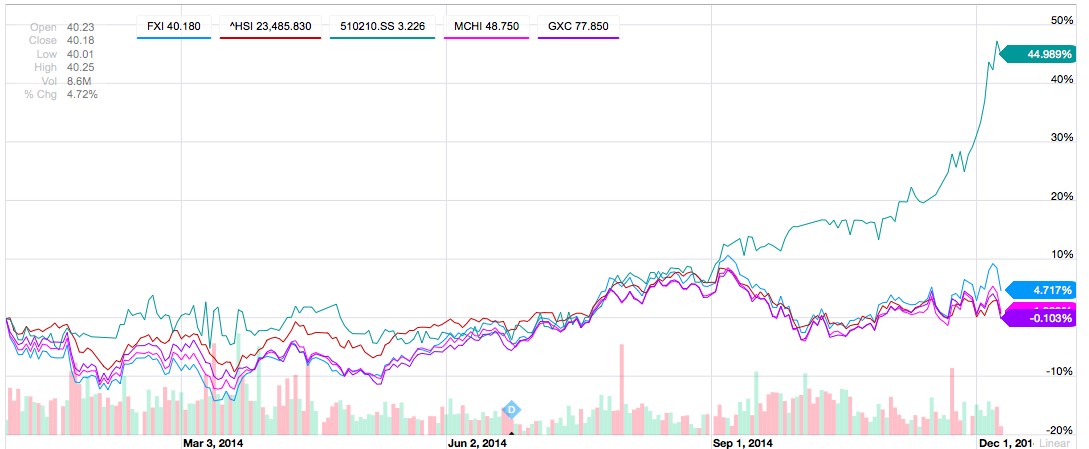Tax Differences Between MLP ETNs And ETFs Explained
Post on: 2 Июнь, 2015 No Comment

by Michael Johnston on March 3, 2011 | Updated December 8, 2014
With interest rates still hovering near record lows and expected to remain depressed for the foreseeable future, investors have been forced to get creative in their hunt for yield. Some have dialed up exposure to junk bonds. while others have ventured beyond the U.S. border and embraced debt of emerging markets issuers. MLPs have been another increasingly popular option for yield-hungry investors, as this often overlooked corner of the domestic energy market has the potential to offer some juicy current returns that may be more characteristic of bonds than equities [For more actionable ETF investment ideas, sign up for the free ETFdb newsletter ].
Master Limited Partnerships (MLPs) are entities that generally own infrastructure, such as pipelines that transport natural gas and crude oil. In order to qualify as an MLP, a firm must generate at least 90% of its income from what what the IRS deems to be qualifying sources, including the transport or processing of certain energy commodities. MLPs must make quarterly required distributions, which means that they are generally a source of stable and predictable cash flows to investors. And because MLPs are partnerships, they come with certain tax advantagesspecifically, the avoidance of a corporate income tax [read Do You Need An MLP ETF? ].
MLP ETFs Booming
In early 2009 JPMorgan introduced the first exchange-traded product to offer exposure to MLPs, and in the two years since a number of new products targeting this asset class have popped up. There are now eleven ETPs in the MLPs ETFdb Category. as well as inverse and leveraged options for exposure to this sector. At first all of the ETPs offering exposure to MLPs were structured as exchange-traded notes, as this method was believed to be the most efficient means of accessing a basket of MLP securities. In order to be classified as a Registered Investment Company under the 1940 Act, a fund can have no more than 25% of its portfolio in MLPs. Because ETNs are debt securities, they allow investors to enjoy the diversification benefits inherent in ETFs without adding another layer of taxes.
Among those eleven ETPs is the Alerian MLP ETF (AMLP ), which ALPS launched in August 2011. AMLP was the first MLP product structured as a true ETF. Unlike most ETFs, AMLP is structured as a C-corporation in order to be allowed to invest exclusively in MLPs. That election also adds some complexity to the tax picture, the ramifications of which have been the subject of significant debate and tremendous confusion in recent months [read MLP ETFs Fact And Fiction ].
AMLPs successit has accumulated nearly $800 million in assets in just a few monthsindicates an abundance of investor interest in accessing MLPs through the ETF structure. But the introduction of AMLP also sparked some debate among investors, with some declaring it to be a flawed product destined to lag behind similar ETNs. Since its inception, AMLP has trailed the UBS E-TRACS Alerian MLP Infrastructure Index ETN (MLPI ), which is linked to the same index, by a fairly wide margin:
Two Years of AMLP and MLPI
While this difference in performance is due primarily to the tax characteristics of these two securities, investors shouldnt draw conclusions on the universal superiority of one vehicle or another based on the above. In reality, there are tax pros and cons to both the ETF and ETN vehicles, and the relative performance of AMLP and MLPI will depend on a number of factors. To understand how the selection of a vehicle can impact the bottom line returns realized by investors, we take a deeper dive and consider the performance that can be expected under various scenarios [see MLP ETFs: Fact and Fiction ].
Variables

When determining the performance that can be expected from each type of vehicle, there are several variables that will impact bottom line gains or losses:
- Individual Income Tax Rate: For investors in an MLP ETN, distributions will be taxed at the individual income rate. As such, the higher the individual income tax rate, the lower the total returns for an MLP ETN (meaning that the extension of the 35% maximum individual rate under the Bush tax cuts was good news for investors in MLP ETNs). [see ETF Winners & Losers From The Great Tax Compromise ]
- Corporate Tax Rate: For investors in an MLP ETF, a portion of the distributions will often be taxed as a return of capital and a portion will be subject to corporate income taxes (according to Wells Fargo, return of capital has historically comprised about 80% of total distribution). As such, the higher the corporate tax rate, the higher the potential tax liability for an MLP ETF.
- Return Of Capital: Distributions treated as return of capital are taxed at more favorable rates than regular distributionsso the greater this percentage, the more advantageous the ETF structure will be when it comes to distributions (as mentioned above, historically return of capital has comprised about 80% of total MLP distributions).
- Source Of Return: In general, the ETN is more efficient when it comes to returns generated through capital appreciation while the ETF can be more efficient when it comes to returns generated through distributions. As such, the mix between these two sources of return will have an impact on the ultimate, bottom line, after tax returns generated.
- Tax Status: This is perhaps the most important variable in this entire equation, and unfortunately the variable whose impact is the most challenging to quantify. The ability to defer taxes for extended periods of time (or even indefinitely) may make achieving MLP exposure through an ETF more appealing, as we discuss in a bit more detail below.
To illustrate more explicitly how each of these variables translates into bottom line returnsand to dispel some of the myths about inherent advantages and disadvantages of various structureswe outline below three different scenarios. Making some assumptions, each scenario considers a different value for the capital appreciation portion of total return [see 50+ All-ETF Model Portfolios ].
- For the ETF, 80% of distributions are treated as return of capital (assuming 90% would enhance returns to ETF, while assuming 70% would lead to less favorable results for the ETF).
- Distribution yield is 6.2%, approximating the current annual yield on the Alerian MLP Infrastructure Index .
- Beginning NAV for both securities of $100
- Individual income tax rate and corporate tax rate are 35%, consistent with current legislation
- Qualified dividend tax rate and long-term capital gains rate are 15%, consistent with current legislation
After Tax Distribution
The first component of total return that must be considered is the after-tax distribution. For the ETN, this calculation is pretty straightforward: the distribution is taxed at the individual income tax rate. Assuming a distribution of $6.20 and a 35% rate, the after-tax distribution is $4.03.














